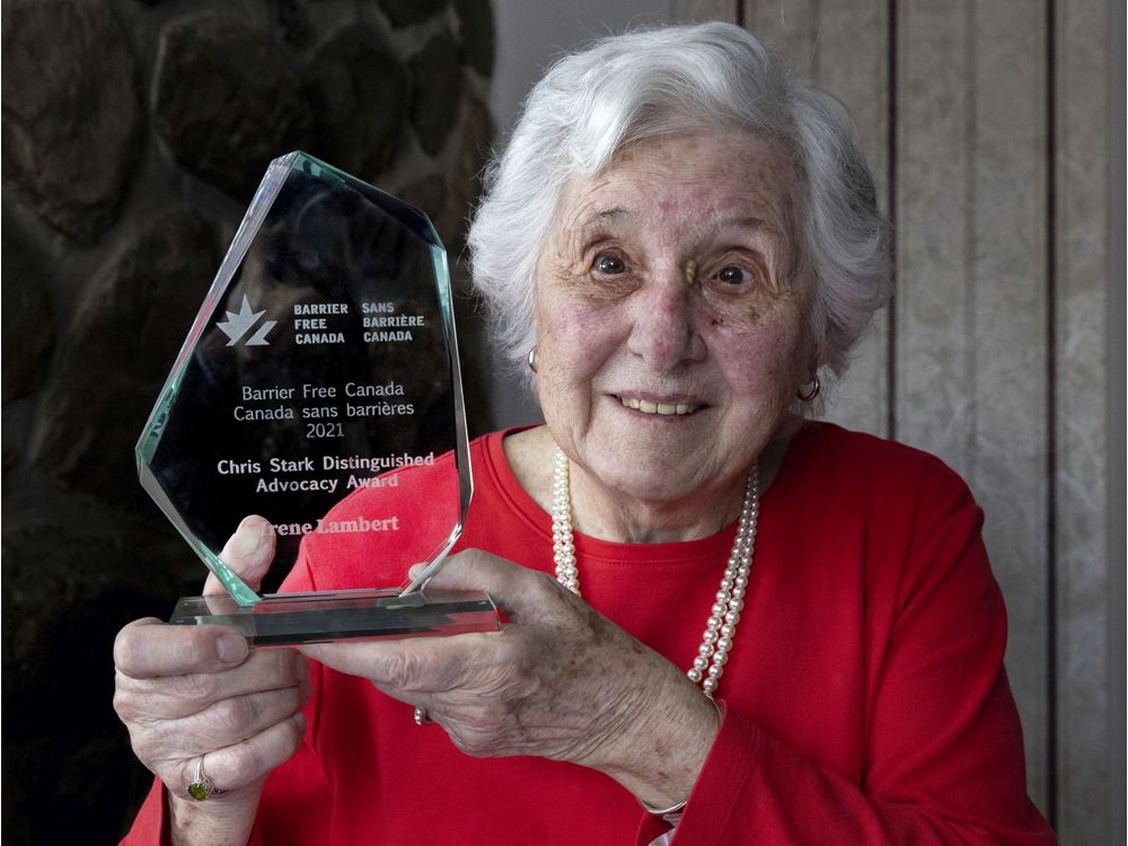About Irene Lambert
Irene Lambert has been a tireless advocate for Canadians with disabilities. She "has fought countless battles in order to ensure that the rights of Canadians with disabilities are recognized and protected."
~ Barrier Free Canada, 2021, September 25.
Chris Stark Distinguished Advocacy Award

In 2021, Irene Lambert was honored with the Chris Stark Distinguished Advocacy Award by Barrier Free Canada in recognition of her lifelong contributions to disability rights and accessible communities.
Advocacy History
"This is a reorganized summary of the list of my various advocacy activities, as far as I could remember, that was submitted by Leo Bissonnette Ph.D. to Barrier Free Canada for the Chris Stark Distinguished Advocacy Award."
~ Irene Lambert, 2021 Chris Stark Award Recipient.
Summary of Canadian Advocacy activities 1969 to 2021
1969–1975:
- In August 1969, I returned to Montreal, Canada, with my husband, Dr. Robert Lambert, our three sons, and two golden retriever guide dogs we trained ourselves. We faced numerous accessibility challenges, particularly the lack of public acceptance for guide dogs. After unsuccessful negotiations with the Board of Place des Arts, we engaged civil rights attorney Claud Armand Shepard, leading to significant media attention.
- I worked with the Guide Dog Foundation in Smithtown, NY, conducting recruitment and evaluations, and advocated for broad recognition of various guide dog training centers. With my husband, I contributed to governmental briefs, urging the establishment of equal rights and services for visually impaired citizens. This effort culminated in the Girard Commission and the passing of “An Act to Ensure the Handicapped in the Exercise of Their Rights” in 1978.
- Guide Dog Foundation Liaison (1970–75): Evaluated candidates and promoted diverse training centers.
1978–2015:
- Legislative Contributions: Active participation in the Girard Commission and supporting legislation for the rights of the handicapped.
- Community Involvement: Initiated a food co-op, organized Block Parents, advanced recycling efforts, and served on the PTA.
- Concordia University: Coordinated research projects and advocated for student support services.
- Organizational Leadership: Held key positions in Low Vision Self-Help Association, Quebec Blind Lawn Bowling Association, and Montreal Association for the Blind.
- International Advocacy: Participated in educational exchanges in China and various national advocacy organizations (ACB, NFB, AEBC, AER).
- Personal Accomplishments: Earned a marine radio operator certificate in 2013.
2015–2021:
- Quebec Accessible: Member since 2015, aimed at updating existing legislation.
- Additional Advocacy Efforts: Campaigns for taxi legislation ensuring guide dog accessibility. Projects with AEBC focusing on transportation, traffic signal accessibility, and personal advocacy.
Recent Activities (2022):
- Active member of LVSHA, organizing events and mentoring.
- Guest speaker on the Triple Vision Podcast.
- Contributed to research on Schools for the Blind in Canada.
- Featured in various publications for advocacy achievements.
Personal Accomplishments:
- First partially sighted student at Lachine High School (1942).
- Held pioneering leadership roles in several advocacy organizations.
This summary reflects a lifelong commitment to advocacy for individuals with visual impairments, highlighting both legislative achievements and community engagement.
Press Clippings & Advocacy Awards
The following list contains links to Press Clippings about Irene Lambert, followed by photos of several Advocacy Awards she received for her advocacy and dedication to helping to establish civil rights, and improve the opportunities and circumstances for Blind and Disabled Canadiens during a decades-long voluntary career of advocacy and service work.
- A Tribute to the Late Chris Stark by Donna J. Jodhan, published in 2019, Barrier Free Canada
- 2021_Nov_Barrier_Free_Canada_Award.png
- 2022_FALL_Habilitas.pdf
- 2022_FEB10_MontrealGazette.pdf
- 2022_JAN-JUN_NLSDonnaKohSummary_V45No1.pdf
- 2022_JAN17_TheSuburban_CityNews.pdf
- 2022_MAY_TheInformer_V50No4.pdf
- 2023_MAY31_TheSuburban_WestIslandNews.pdf
CLICK THIS LINK TO OPEN a single PDF document containing all of the Press Clippings listed above.
More Info
To learn more about Irene Lambert’s advocacy, community service, or to invite her for a conversation, please get in touch.
- Email: Irene Lambert
- LinkedIn Profile